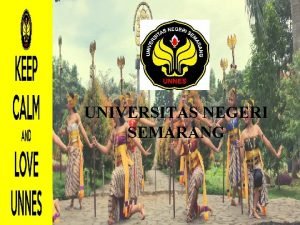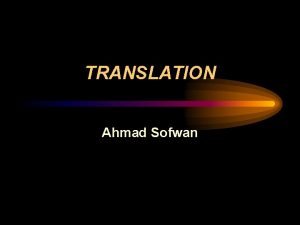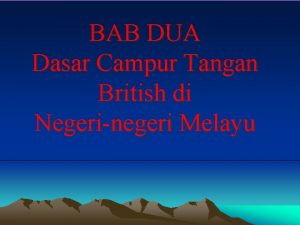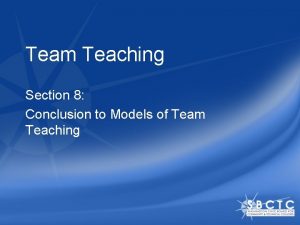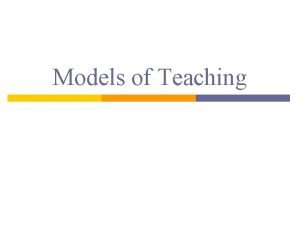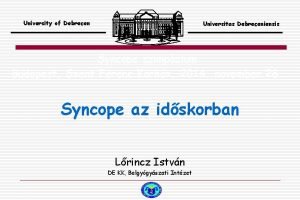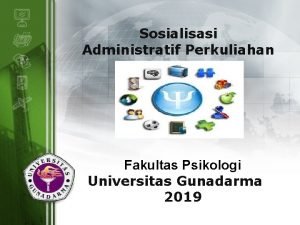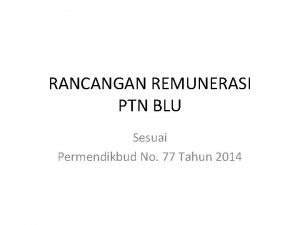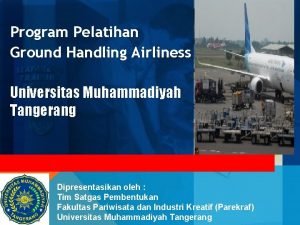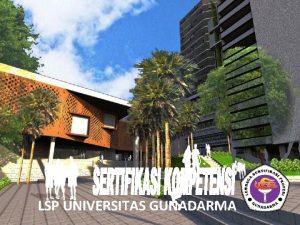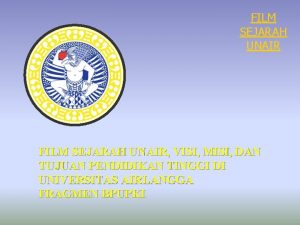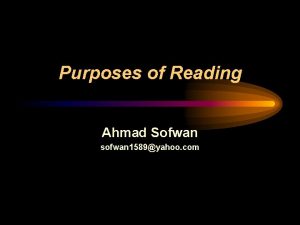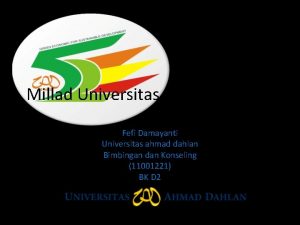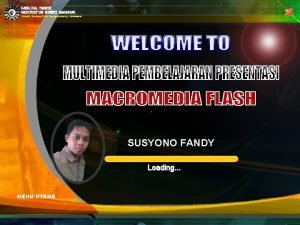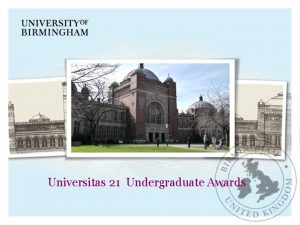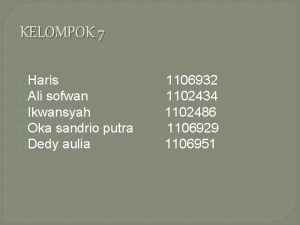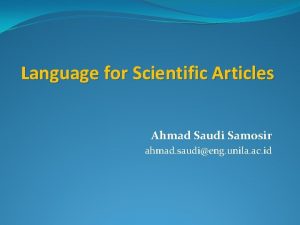1 LANGUAGE TEACHING MODELS Ahmad Sofwan Universitas Negeri


















- Slides: 18

1 LANGUAGE TEACHING MODELS Ahmad Sofwan Universitas Negeri Semarang

Teacher-centered model Ú It is the method by which they were taught Ú It makes sense: The teacher should be the focus of the classroom, since the teacher knows the language and the students do not Ú It requires relatively little preparation: All the teacher needs to do is present the material outlined in the appropriate chapter of the book 2

Ú It requires relatively little thought about student or student activities: All student listen to the same (teacher) presentation, then do related exercises Ú It involves only a minority of students in actual language learning Ú It gives students knowledge about the language, but does not necessarily enable them to use it for purposes that interest them 3

Learner-centered model Ú Language learning is a process of discovery. Ú Learner develops ability to use the language for specific communication purposes. Ú Teacher models language use and facilitates students' development of language skills. Ú Both student and teacher are active participants who share responsibility for the student's learning. 4

Ú Teacher and students work together to identify how students expect to use the language. Ú The teacher models correct and appropriate language use, and students then use the language themselves in practice activities that simulate real communication situations. Ú The active, joint engagement of students and teacher leads to a dynamic classroom environment in which teaching and learning become rewarding and enjoyable 5

Guidelines for Communicative, Learner-centered Instruction Ú Ú Ú Ú Ú Provide appropriate input Use language in authentic ways Provide context Design activities with a purpose Use task-based activities Encourage collaboration Use an integrated approach Address grammar consciously Adjust feedback/error correction to the situation Include awareness of cultural aspects of language use 6

1. Provide Appropriate Input Ú Input is the language to which students are exposed: teacher talk, listening activities, reading passages, and the language heard and read outside of class. Ú Input gives learners the material they need to develop their ability to use the language on their own. Ú Language input has two forms. Finely tuned input and Roughly tuned input 7

2. Use Language in Authentic Ways Ú Students need as much as possible to hear and read the Ú Ú language as native speakers use it. Teacher talk: Always try to use the language as naturally as possible when you are talking to students. Slowing down may seem to make the message more comprehensible, but it also distorts the subtle shifts in pronunciation that occur in naturally paced speech. Speak at a normal rate Use vocabulary and sentence structures with which students are familiar State the same idea in different ways to aid comprehension 8

Ú Materials: Give students authentic reading material from Ú Ú Ú newspapers, magazines, and other print sources. Review them carefully to ensure that the reading level is appropriate Introduce relevant vocabulary and grammatical structures in advance Provide context by describing the content and typical formats for the type of material (for example, arrival and departure times for travel schedules) Advertisements, travel brochures, packaging, and street signs contain short statements that students at lower levels can manage. The World Wide Web is a rich resource for authentic materials. Reading authentic materials motivates students at all levels because it gives them the sense that they really are able to use the language. 9

3. Provide Context Ú the topic or content Ú the vocabulary and language structures in which the content is usually Ú Ú Ú presented the social and cultural expectations associated with the content prepare the material by raising their awareness of the context in which it occurs. Ask students what they know about the topic Ask what they can predict from the title or heading of a reading selection or the opening line of a listening selection Review the vocabulary (including idiomatic expressions) and sentence structures that are usually found in that type of material Review relevant social and cultural expectations 10

4. Design Activities with a Purpose Ú Ordinarily, communication has a purpose: to convey information. Ú Activities in the language classroom simulate communication outside the classroom when they are structured with such a purpose. Ú Students use the language to fill an information gap by getting answers or expanding a partial understanding. For example, students work in pairs, and each is given half of a map, grid, or list needed to complete a task. The pair then talk to each other until they both have all the information 11

5. Use Task-based Activities Ú Fluent speakers use language to perform tasks such as solving problems, developing plans, and working together to complete projects. Ú The use of similar task-based activities in the classroom is an excellent way to encourage students to use the language. Ú Tasks may involve solving a word problem, creating a crossword puzzle, making a video, preparing a presentation, or drawing up a plan 12

6. Encourage Collaboration Ú Whenever possible, ask students to work in pairs or small groups. Ú Give students structure in the form of a defined task and outcome. This structure will allow students to collaborate as they develop a work plan, discuss the substance of the task, and report the outcome. They will thus use language in a variety of ways and learn from each other. 13

7. Use an Integrated Approach Ú Mode integration is the combination of listening, speaking, reading, and writing in classroom activities. By asking students to use two or more modes, teachers create activities that imitate real world language use. Ú Content integration is bringing content from students’ fields of study into the language curriculum. 14

8. Address Grammar Consciously Ú Discuss points of grammar in the contexts where they arise. Ú Asking students to think through a rule in the context of an effort to express themselves clearly is a more effective way of helping them internalize the rule than teaching the rule in isolation. 15

9. Adjust Feedback/Error Correction to Situation Ú In the parts of a lesson that focus on form, direct and immediate feedback is needed and expected. Ú Encourage students to self-correct by waiting after they have spoken or by asking them to try again. Ú Paraphrase a student's utterances, modeling the correct forms Ú Ask students to clarify their utterances, providing paraphrases of their own 16

10. Include Awareness of Cultural Aspects of Language Use Ú Include information on the social, cultural, and historical context that certain language forms carry for native speakers. Often these explanations include reference to what a native speaker would say, and why. Ú Using media as authentic materials in the classroom can expand students’ perspectives and generate interesting discussions about the relationships between language and culture. 17

THE END thank you 18
 Visi universitas negeri semarang
Visi universitas negeri semarang Unnesapp
Unnesapp Sofwan meaning
Sofwan meaning Sofwan dahlan
Sofwan dahlan Sofwan dahlan
Sofwan dahlan Faktor campur tangan british di tanah melayu
Faktor campur tangan british di tanah melayu What is the difference between models & semi modals?
What is the difference between models & semi modals? Conclusion for models of teaching
Conclusion for models of teaching Cooperative learning
Cooperative learning 4 families of models of teaching
4 families of models of teaching Micro teaching is a scaled down teaching
Micro teaching is a scaled down teaching Universitas debreceniensis
Universitas debreceniensis Kepemimpinan iowa
Kepemimpinan iowa Contoh pi psikologi gunadarma
Contoh pi psikologi gunadarma Remunerasi blu universitas
Remunerasi blu universitas Biaya masuk universitas muhammadiyah tangerang
Biaya masuk universitas muhammadiyah tangerang Luas universitas mataram
Luas universitas mataram Lsp universitas gunadarma
Lsp universitas gunadarma Visi universitas airlangga
Visi universitas airlangga
